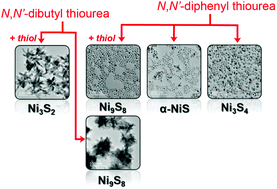Our official English website, www.x-mol.net, welcomes your
feedback! (Note: you will need to create a separate account there.)
Phase control in the colloidal synthesis of well-defined nickel sulfide nanocrystals†
Nanoscale ( IF 5.8 ) Pub Date : 2018-08-16 00:00:00 , DOI: 10.1039/c8nr05208e Gözde Barim 1, 2, 3, 4 , Sara R. Smock 1, 2, 3, 4 , Priscilla D. Antunez 1, 2, 3, 4 , Daniela Glaser 1, 2, 3, 4 , Richard L. Brutchey 1, 2, 3, 4
Nanoscale ( IF 5.8 ) Pub Date : 2018-08-16 00:00:00 , DOI: 10.1039/c8nr05208e Gözde Barim 1, 2, 3, 4 , Sara R. Smock 1, 2, 3, 4 , Priscilla D. Antunez 1, 2, 3, 4 , Daniela Glaser 1, 2, 3, 4 , Richard L. Brutchey 1, 2, 3, 4
Affiliation

|
Morphologically well-defined colloidal nanocrystals of Ni3S4, NiS, Ni9S8, and Ni3S2 were independently prepared through a solution-phase synthesis using N,N′-disubstituted thioureas as the sulfur precursor. Synthetic control over phase and composition of the resulting colloidal nickel sulfide nanocrystals was achieved by primarily adjusting the reactivity of substituted thioureas as well as tuning the key reaction parameters of temperature and precursor ratio. In general, the more reactive N,N′-diphenyl thiourea yields more sulfur-rich phases (Ni3S4 and NiS) while less reactive N,N′-dibutyl thiourea yields sulfur-poor phases (Ni9S8 and Ni3S2). This phase control can be further tuned through the use of 1-dodecanethiol as an important secondary reactivity-directing agent. In the presence of 1-dodecanethiol, nanocrystals of more sulfur-deficient phases are prepared, while in the absence of 1-dodecanethiol, more sulfur-rich phases are prepared. Under the most sulfur-rich synthetic conditions (i.e., with N,N′-diphenyl thiourea and no thiol) a phase progression from Ni3S4 to the α-NiS and β-NiS phases was observed upon an increase in reaction temperature and sulfur-to-nickel precursor ratio. This study establishes, for the first time, a systematic evaluation of factors that simultaneously control the phase and yield well-defined nickel sulfide nanocrystals.
中文翻译:

明确定义的硫化镍纳米晶体的胶体合成中的相控†
Ni 3 S 4,NiS,Ni 9 S 8和Ni 3 S 2的形态明确的胶体纳米晶体是通过使用N,N'-二取代的硫脲作为硫前体的固溶相合成而独立制备的。通过主要调节取代的硫脲的反应性以及调节温度和前体比的关键反应参数,实现了对所得胶态硫化镍纳米晶体的相和组成的合成控制。通常,反应性更高的N,N'-二苯基硫脲可产生更多的富硫相(Ni 3 S4和NiS),而N, N'-二丁基硫脲的反应性较低,则生成的硫相较差(Ni 9 S 8和Ni 3 S 2)。通过使用1-十二烷硫醇作为重要的二级反应性导向剂,可以进一步调节该相控制。在1-十二烷硫醇的存在下,制备了更多的硫缺乏相的纳米晶体,而在没有1-十二烷硫醇的情况下,制备了更多的富硫相。在最富硫的合成条件下(即在使用N, N'-二苯基硫脲和无硫醇的情况下),相从Ni 3 S 4演变而来随着反应温度和硫镍镍前体比的增加,α-NiS和β-NiS相发生了相变。这项研究首次建立了同时控制相并产生明确的硫化镍纳米晶体的因素的系统评估。
更新日期:2018-08-16
中文翻译:

明确定义的硫化镍纳米晶体的胶体合成中的相控†
Ni 3 S 4,NiS,Ni 9 S 8和Ni 3 S 2的形态明确的胶体纳米晶体是通过使用N,N'-二取代的硫脲作为硫前体的固溶相合成而独立制备的。通过主要调节取代的硫脲的反应性以及调节温度和前体比的关键反应参数,实现了对所得胶态硫化镍纳米晶体的相和组成的合成控制。通常,反应性更高的N,N'-二苯基硫脲可产生更多的富硫相(Ni 3 S4和NiS),而N, N'-二丁基硫脲的反应性较低,则生成的硫相较差(Ni 9 S 8和Ni 3 S 2)。通过使用1-十二烷硫醇作为重要的二级反应性导向剂,可以进一步调节该相控制。在1-十二烷硫醇的存在下,制备了更多的硫缺乏相的纳米晶体,而在没有1-十二烷硫醇的情况下,制备了更多的富硫相。在最富硫的合成条件下(即在使用N, N'-二苯基硫脲和无硫醇的情况下),相从Ni 3 S 4演变而来随着反应温度和硫镍镍前体比的增加,α-NiS和β-NiS相发生了相变。这项研究首次建立了同时控制相并产生明确的硫化镍纳米晶体的因素的系统评估。











































 京公网安备 11010802027423号
京公网安备 11010802027423号